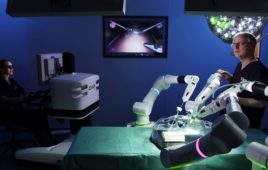According to Dr. Shinsuke Sakakibara, president of the International Federation of Robotics, 2011 was the most successful year for industrial robots in 50 years. At the AUTOMATICA in Munich, Germany, Sakakibara referenced the fact that 2.3 million have been sold all over the world since the first robotic installation in 1961.
“In 2011, about 165,000 industrial robots were sold worldwide, by far the highest level ever recorded, 37% more than 2010,” said Arturo Baroncelli, VP of IFR. “The impetuous increase of demand in 2010 and 2011 following the worldwide financial and economic crisis exceeded all our expectations. We expect that in 2012, robot sales will further increase with a more reduced growth rate and again reach a new peak level,” he added. “The use of robots always guarantees fast return on investments and dramatic improvements in terms of quality. And this is true both in the car and the general industry, both in emerging countries and in nations having a long industrial tradition.”
Three of the countries most responsible for the increase were China, the U.S. and Germany, with growth rates of robot sales between 39% and 51%. All three countries reached new peak levels. The two biggest markets trended slightly lower—Japan was back on top with almost 28,000 industrial robots, 27% more than 2010. Robot sales to South Korea increased by 9% to 25,500 units.
China has been the most rapidly growing market over the last several years, with the exception of 2009. In 2011, almost 22,600 industrial robots were supplied to China, and by 2014, it will surpass Japan to top the robot market worldwide.
As in 2010, the automotive industry strongly increased robot investments. Continuing modernization and increase of capacities in emerging markets were the main reasons for this. The trend towards automation, especially in the metal and machinery industry, boosted robot sales there. The electrical/electronics industry—which almost tripled robot installations in 2010—increased robot orders again, but with a lower growth rate.
According to the IFR, increased productivity will be required to offset labor shortages and the higher costs associated with the demographic shifts that are being seen in many countries. It is also key to note that sustainability, eco-friendly production and energy-saving measures are becoming increasingly visible all over the world. New production processes have to be installed. Automation provides solutions for all these challenges and industrial robots are key components of that.
International Federation of Robotics
www.ifr.org
Filed Under: The Robot Report, MECHANICAL POWER TRANSMISSION, Mechatronics






Labor shortage? With unemployment at 8-9% we hardly have a labor shortage. China is “overpopulated”, how could they have a labor shortage? Be honest, Robots don’t get medical or dental benefits, never require paid sick time, don’t take vacations and you can cuss them out without any repercussions. You pay for a robot once and you pay a person over and over. A robot never gets a raise and the quality of their work doesn’t fluctuate because their spouse left them, or their kid is sick.
Does this mean that humans will no longer participate in the economy? Or does it mean that they will have a decreased role in the economy? Perhaps the legal entities called companies will be making products for other companies to buy. An economic model that precludes all but shareholders. Society be damned.
The labor shortages will be due to demographic shifts. Right now, China still is still in the sweet spot in which the largest portion of its people are still of working age, but that will only last another 10 or so years, courtesy mostly of the one-child policy. Japan is already largely there.
And yes, you are on the money — it is a shortage of “cheap” semi-skilled labor. And robots are getting cheaper, more functional, safter and easier to program at an accelerating rate. You left out that human workers take time to train to do the job well, and are more prone to turnover. This is especially true in China where the preferred laborers — young women as they are more reliable, pliant and frankly, capable — tend to be more upwardly mobile or to leave due to getting married or having a child.
Note I’m not saying any of this is as it should be — merely describing how it is.
There is a labor shortage here in the US for skilled manufacturing workers. Last report I read, there were 600,000 manufacturing vacancies.
It means none of those things. Robots require people to design them, build them, test them, manufacture them, service them, sell them, provide customer service for them, and operate them. Tell me, who makes products now for not only other companies but consumers as well? Companies do, in case you got that wrong.